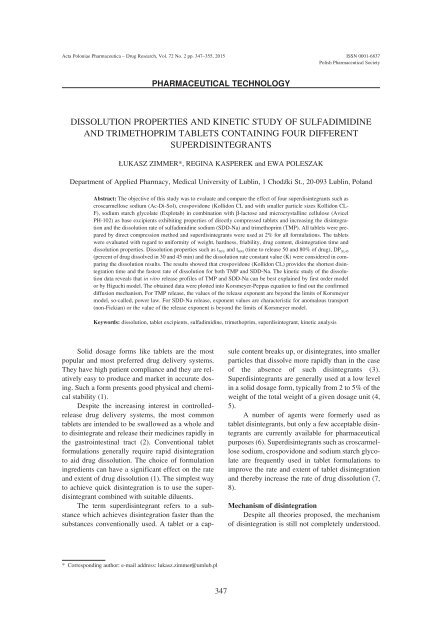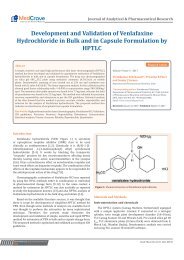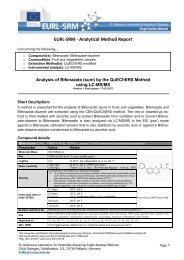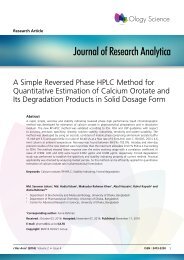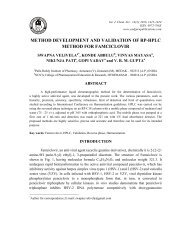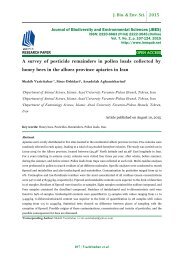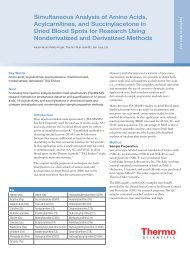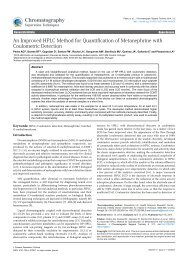acta 2_2015
acta 2_2015
acta 2_2015
- No tags were found...
You also want an ePaper? Increase the reach of your titles
YUMPU automatically turns print PDFs into web optimized ePapers that Google loves.
Acta Poloniae Pharmaceutica ñ Drug Research, Vol. 72 No. 2 pp. 347ñ355, <strong>2015</strong> ISSN 0001-6837Polish Pharmaceutical SocietyPHARMACEUTICAL TECHNOLOGYDISSOLUTION PROPERTIES AND KINETIC STUDY OF SULFADIMIDINEAND TRIMETHOPRIM TABLETS CONTAINING FOUR DIFFERENTSUPERDISINTEGRANTS£UKASZ ZIMMER*, REGINA KASPEREK and EWA POLESZAKDepartment of Applied Pharmacy, Medical University of Lublin, 1 Chodüki St., 20-093 Lublin, PolandAbstract: The objective of this study was to evaluate and compare the effect of four superdisintegrants such ascroscarmellose sodium (Ac-Di-Sol), crospovidone (Kollidon CL and with smaller particle sizes Kollidon CL-F), sodium starch glycolate (Explotab) in combination with β-lactose and microcrystalline cellulose (AvicelPH-102) as base excipients exhibiting properties of directly compressed tablets and increasing the disintegrationand the dissolution rate of sulfadimidine sodium (SDD-Na) and trimethoprim (TMP). All tablets were preparedby direct compression method and superdisintegrants were used at 2% for all formulations. The tabletswere evaluated with regard to uniformity of weight, hardness, friability, drug content, disintegration time anddissolution properties. Dissolution properties such as t 50% and t 80% (time to release 50 and 80% of drug), DP 30,45(percent of drug dissolved in 30 and 45 min) and the dissolution rate constant value (K) were considered in comparingthe dissolution results. The results showed that crospovidone (Kollidon CL) provides the shortest disintegrationtime and the fastest rate of dissolution for both TMP and SDD-Na. The kinetic study of the dissolutiondata reveals that in vitro release profiles of TMP and SDD-Na can be best explained by first order modelor by Higuchi model. The obtained data were plotted into Korsmeyer-Peppas equation to find out the confirmeddiffusion mechanism. For TMP release, the values of the release exponent are beyond the limits of Korsmeyermodel, so-called, power law. For SDD-Na release, exponent values are characteristic for anomalous transport(non-Fickian) or the value of the release exponent is beyond the limits of Korsmeyer model.Keywords: dissolution, tablet excipients, sulfadimidine, trimethoprim, superdisintegrant, kinetic analysisSolid dosage forms like tablets are the mostpopular and most preferred drug delivery systems.They have high patient compliance and they are relativelyeasy to produce and market in accurate dosing.Such a form presents good physical and chemicalstability (1).Despite the increasing interest in controlledreleasedrug delivery systems, the most commontablets are intended to be swallowed as a whole andto disintegrate and release their medicines rapidly inthe gastrointestinal tract (2). Conventional tabletformulations generally require rapid disintegrationto aid drug dissolution. The choice of formulationingredients can have a significant effect on the rateand extent of drug dissolution (1). The simplest wayto achieve quick disintegration is to use the superdisintegrantcombined with suitable diluents.The term superdisintegrant refers to a substancewhich achieves disintegration faster than thesubstances conventionally used. A tablet or a capsulecontent breaks up, or disintegrates, into smallerparticles that dissolve more rapidly than in the caseof the absence of such disintegrants (3).Superdisintegrants are generally used at a low levelin a solid dosage form, typically from 2 to 5% of theweight of the total weight of a given dosage unit (4,5).A number of agents were formerly used astablet disintegrants, but only a few acceptable disintegrantsare currently available for pharmaceuticalpurposes (6). Superdisintegrants such as croscarmellosesodium, crospovidone and sodium starch glycolateare frequently used in tablet formulations toimprove the rate and extent of tablet disintegrationand thereby increase the rate of drug dissolution (7,8).Mechanism of disintegrationDespite all theories proposed, the mechanismof disintegration is still not completely understood.* Corresponding author: e-mail address: lukasz.zimmer@umlub.pl347


